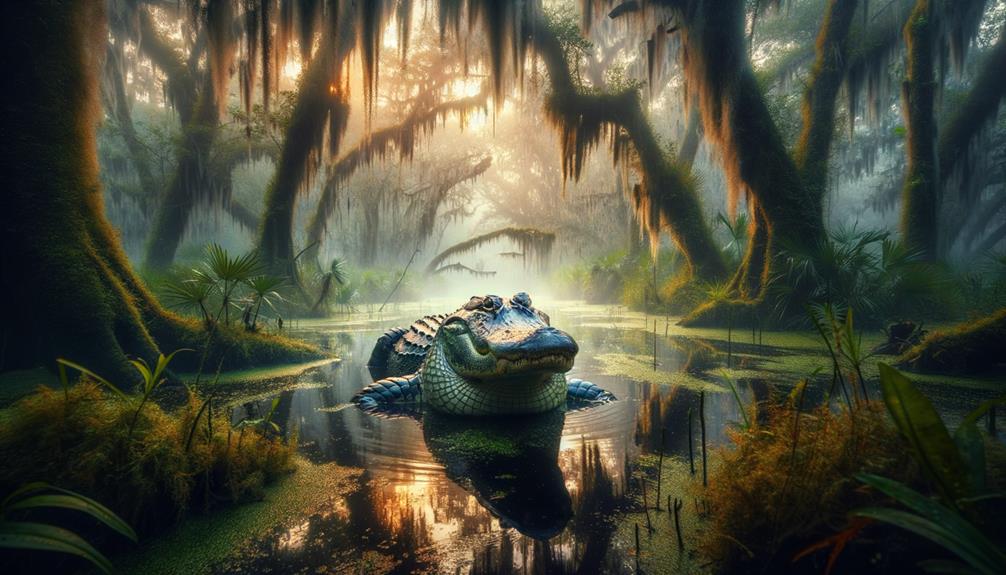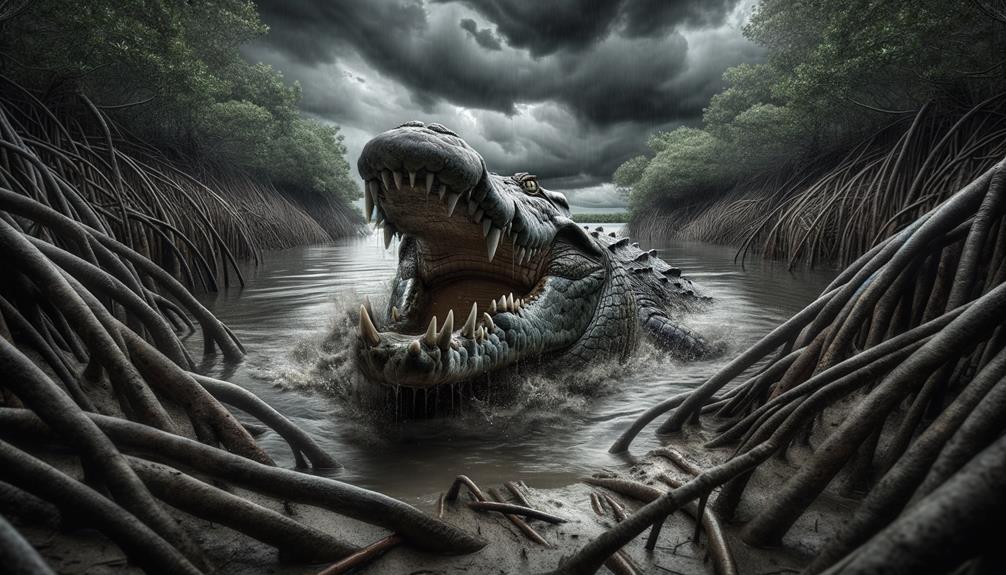I find Cuvier's dwarf caimans fascinating, as they hold the title of the smallest crocodilians. Males reach up to only 1.6 meters in length, while females reach 1.2 meters. Their petite size belies their well-armored bodies, complete with bony osteoderms, and their short, concave snouts are perfect for nocturnal hunting. Native to the Amazon Basin, they thrive in flooded forests and fast-flowing rivers. These territorial creatures use vocalizations and physical displays to assert dominance. What's more, they have a diverse diet that ranges from fish to small mammals. If you're curious about their complex behaviors and unique adaptations, you're in the right place.
Key Takeaways
Cuvier's Dwarf Caimans are the smallest crocodilians, with males reaching up to 1.6 meters in length and females up to 1.2 meters. They typically weigh between 6-7 kg, although some exceptional individuals can reach up to 37 kg. Their robust bodies are protected by bony osteoderms, providing them with a natural armor. Their short, upturned, and concave snout is well-suited for nocturnal hunting. These adaptable creatures thrive in diverse Amazon Basin environments, from fast-flowing rivers to seasonally flooded forests.
Etymology
Delving into the etymology of Cuvier's dwarf caiman reveals that the genus name, Paleosuchus, combines the Greek words 'palaios' meaning 'ancient' and 'soukhos' meaning 'crocodile'. This nomenclature evokes a sense of timelessness, linking these small yet resilient creatures to their prehistoric ancestors. The genus Paleosuchus comprises two species: Paleosuchus trigonatus and Paleosuchus palpebrosus.
The species name palpebrosus is derived from the Latin words 'palpebra' meaning 'eyelid' and 'osus' meaning 'full of'. This descriptive title likely alludes to the distinctive characteristics of its eyes, setting it apart from other crocodilian species. It's fascinating how these names capture both the ancient lineage and specific anatomical features of these caimans.
The choice of terms like palaios and soukhos isn't just academic; it's also a poetic nod to their enduring presence in the natural world. Meanwhile, the terms palpebra and osus offer a glimpse into the nuanced physical traits that define them. Understanding these names enriches our appreciation for Paleosuchus trigonatus and Paleosuchus palpebrosus, revealing a deeper narrative woven into their scientific classification.
Physical Characteristics
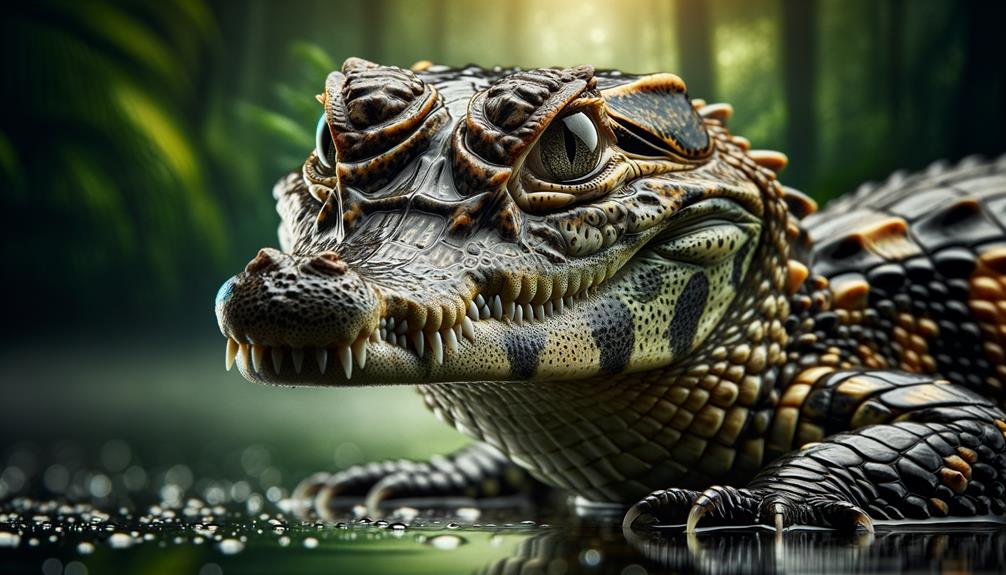
Physical Characteristics
Cuvier's dwarf caiman is a striking creature, with males reaching a maximum length of 1.6 meters and females topping out at 1.2 meters. Despite their small stature, they possess a robust body covered in formidable armor. Bony osteoderms provide both dorsal and ventral protection, making them resilient inhabitants of their freshwater environments.
Their upturned snout is a distinctive feature, short and concave, adapted for their nocturnal hunting habits. This specialized snout aids in traversing the muddy waters of northern and central South America, where they primarily reside. Adults typically weigh around 6-7 kg, although some exceptional individuals have been recorded at 37 kg, showcasing the variability within this species.
Newly hatched juveniles exhibit a fascinating adaptation: a mucus coating that dries over several days, reducing algal growth on their skin and aiding in their survival. This feature highlights the evolutionary ingenuity of the dwarf caiman, ensuring they remain agile and less prone to skin issues in their aquatic habitats. These physical traits underscore the remarkable adaptability and resilience of Cuvier's dwarf caiman, making them a fascinating subject of study.
Natural Habitat
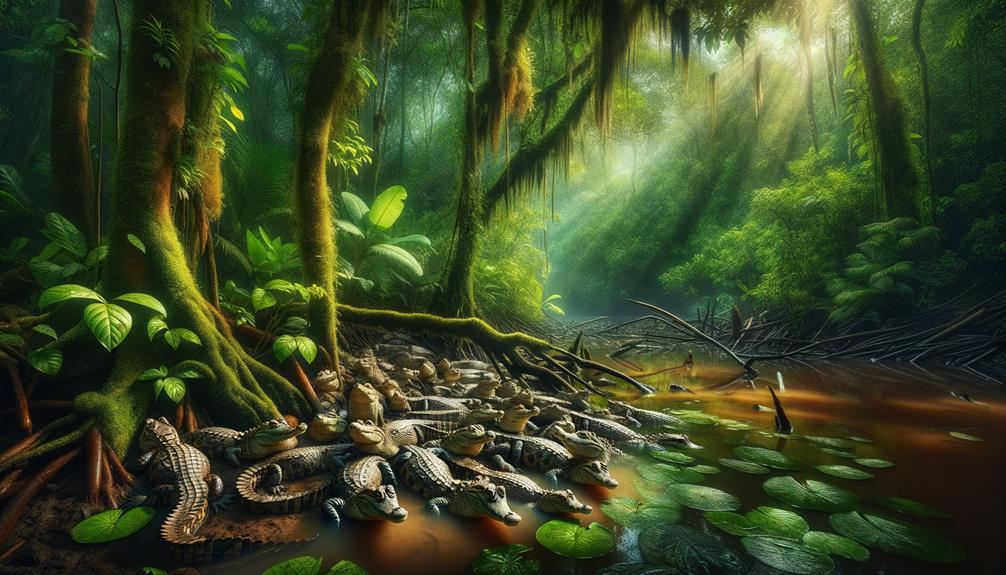
When I venture into the natural habitat of Cuvier's dwarf caimans, I'm struck by how well they thrive in the dynamic environments of the Amazon Basin, with its intricate network of riverbanks and swamps. These caimans are perfectly suited to the rainforest ecosystems, navigating both clear, fast-flowing streams and nutrient-poor waters. Their ability to flourish in such diverse aquatic and riparian habitats highlights their ecological significance and adaptability.
Amazon Basin Environments
Thriving in the Amazon basin's diverse and dynamic environment, Cuvier's dwarf caimans have adapted to the region's fast-flowing rivers, nutrient-poor waters, and seasonally flooded forests. The Amazon's intricate network of rivers and streams provides a complex habitat, rich with ecological niches. The várzea, or seasonally flooded forests, play a pivotal role in this ecosystem. These environments, periodically inundated by the Amazon's annual flood cycle, offer an abundance of aquatic resources and dense vegetation that supports the caimans' survival.
In these nutrient-poor waters, Cuvier's dwarf caimans have developed strong hunting skills, preying on fish, amphibians, and crustaceans. The flooded forests create a labyrinth of submerged trees and plants, where caimans can navigate stealthily and capture their prey. The riparian zones, lush with forest cover, provide ideal nesting sites and protective cover from predators, ensuring the young have a fighting chance.
To survive in this environment, adaptation is crucial. During the dry season, when water levels recede and droughts threaten, Cuvier's dwarf caimans enter a state of dormancy, conserving energy and surviving until the waters rise again. This remarkable resilience showcases their ability to thrive in one of the planet's most challenging habitats.
Riverbanks and Swamps
Exploring the riverbanks and swamps where Cuvier's dwarf caimans live reveals their preference for fast-flowing waters and forested banks, crucial for both their hunting strategies and protective needs. These caimans thrive in the dynamic environments of rivers and streams, particularly within the Orinoco and Amazon basins. Their chosen riverine habitats offer a diverse range of ecological niches, from nutrient-poor stagnant waters to bustling, fast-flowing water courses.
The forested riverine habitats are vital for the caimans, providing ample cover and a diverse prey base. These semi-aquatic reptiles have adapted to both the wet and dry elements of their surroundings, often seeking refuge in burrows or beneath thick vegetation along the riverbanks. This strategic use of habitat not only shields them from predators but also positions them advantageously for ambush hunting.
- Diet Diversity: Cuvier's dwarf caimans prey on fish, amphibians, crustaceans, and small mammals.
- Protective Adaptations: They utilize bony armor for defense in riverine habitats.
- Habitat Versatility: They inhabit both fast-flowing rivers and flooded forests around lakes.
Rainforest Ecosystems
Cuvier's dwarf caimans inhabit the lush and intricate rainforest ecosystems of northern and central South America, where the interplay of aquatic and terrestrial habitats shapes their daily existence. These remarkable reptiles thrive in the dynamic environments of the Amazon and Orinoco basins, demonstrating their adaptability to both riverine habitats and areas.
In these tropical northern and central regions, Cuvier's dwarf caimans utilize flooded forests and lakes as seasonal breeding and nursery grounds. These areas are teeming with life, offering abundant food sources like fish, amphibians, and invertebrates, necessary for the caimans' diet. The presence of these small crocodilians is a critical indicator of a healthy, functioning rainforest ecosystem, as they are sensitive to habitat degradation and pollution.
Habitat destruction poses a significant threat to their survival. Deforestation and the resulting habitat loss can disrupt the delicate balance of these ecosystems, making the conservation of these riverine areas and their diverse inhabitants more important than ever. Protecting these habitats ensures the continued survival of Cuvier's dwarf caimans and the myriad species that share their world.
Behavior Patterns
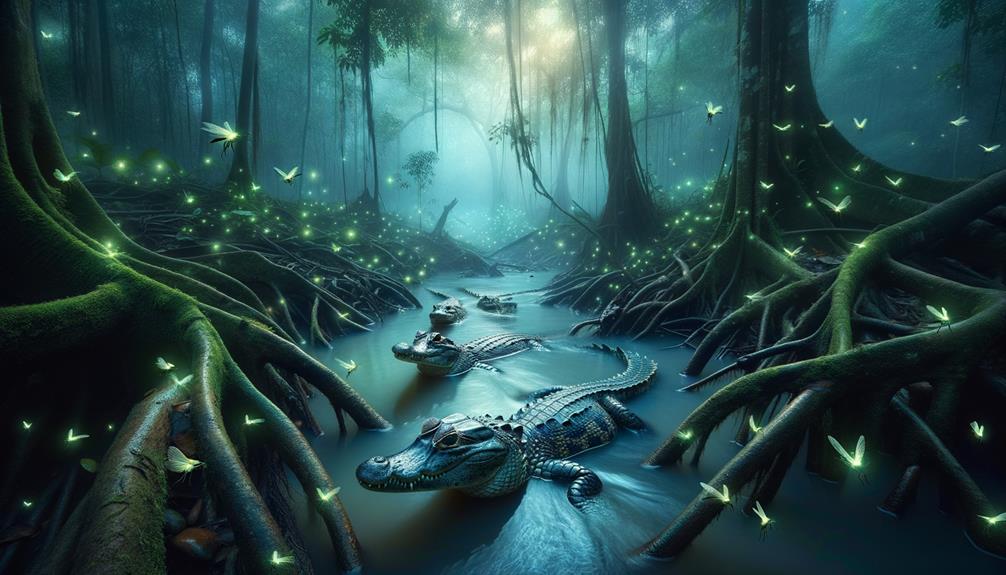
When examining the behavior patterns of Cuvier's dwarf caimans, their unique nocturnal hunting habits and territorial displays stand out. These creatures emerge under the cover of darkness to hunt for fish, amphibians, small mammals, and invertebrates. Their territorial behaviors, often marked by vocalizations and physical posturing, demonstrate a complex social structure and a keen sense of spatial awareness.
Nocturnal Hunting Habits
Under the cover of darkness, Cuvier's dwarf caimans transform into stealthy predators, exploiting their nocturnal habits to ambush unsuspecting prey. Their powerful jaws and sharp teeth make them master hunters as the sun dips below the horizon. Their diet is diverse, ranging from fish and amphibians to small mammals and invertebrates. This nocturnal lifestyle not only helps them evade larger predators but also allows them to conserve energy in the cooler nighttime temperatures.
By utilizing their exceptional camouflage and stealth, they skillfully stalk and ambush prey, whether in water or on land. This strategic approach ensures they can catch their meals with minimal effort. Their small size and agility are assets in these nighttime hunts, allowing them to navigate through dense vegetation and murky waters silently.
Nocturnal Adaptations: These caimans have evolved to hunt effectively under low light conditions.
Diverse Diet: Their diet consists of a wide range of prey, from fish and amphibians to small mammals and invertebrates.
Stealth and Camouflage: Their ability to blend seamlessly into their surroundings makes them formidable nocturnal predators.
In the stillness of the night, these caimans showcase a perfect blend of patience, stealth, and precision, making them efficient hunters of the shadows.
Territorial Display Behaviors
In the dense, intricate ecosystems they inhabit, Cuvier's dwarf caimans exhibit a fascinating array of territorial display behaviors to establish and maintain dominance. As a species, they use head-slapping and tail-wagging as primary methods to assert their presence in the water. These crocodilians also open their jaws wide, a visual signal of their readiness to defend their territory.
Communication is vital among caimans. Loud bellowing calls resonate through their habitat, advertising their presence and deterring intruders. During the breeding season, this communication becomes even more intense. Males engage in fierce head-butting and body-shoving contests, each vying for access to receptive females.
Females, on the other hand, exhibit remarkable maternal aggression. They fiercely defend their nests and hatchlings, chasing away potential threats with unmatched ferocity. Even the juveniles aren't passive; they establish dominance hierarchies through a series of threat displays. Hissing, gaping their mouths, and making short charging rushes, these young caimans learn the intricacies of territoriality early on.
Through these behaviors, Cuvier's dwarf caimans exemplify the complex social structures and communication strategies that allow them to thrive in their watery domains. Their unique adaptations enable them to coexist and interact within their ecosystems, showcasing the intricate dynamics of their social world.
Conservation Status
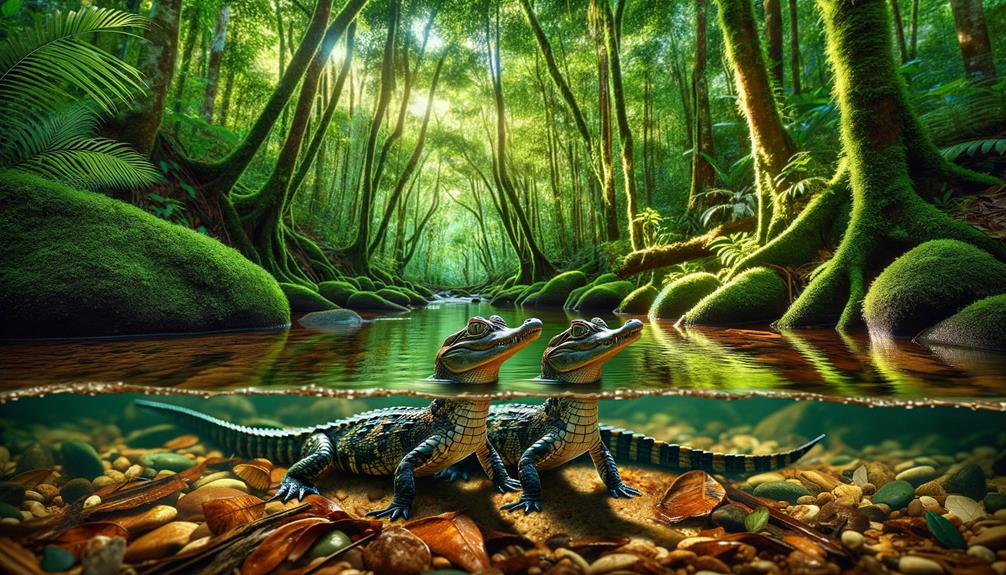
Cuvier's dwarf caiman, classified as Least Concern on the IUCN Red List, boasts stable populations across its native range in northern and central South America. This smallest species of crocodilian has adapted remarkably well to its environment, showing resilience in the face of potential threats like habitat loss and fragmentation. Its tolerance for cool water also expands its habitable range.
However, we cannot ignore the risks entirely. Hunting and poaching persist in some regions, although they do not currently pose major threats to the overall population. Conservation efforts are crucial to maintaining this balance. These initiatives include monitoring and protective measures that safeguard the long-term survival of Cuvier's dwarf caiman.
Regulated trade is in place, with the species listed on CITES Appendix II, helping to prevent overexploitation. Local and international conservation programs focus on preserving natural habitats. Ongoing studies and surveys help track population trends and health.
Despite being on the Red List of Threatened species, the Cuvier's dwarf caiman's stable population is a testament to effective conservation efforts. Maintaining this status requires continuous vigilance and adaptation to emerging threats.
Captive Care
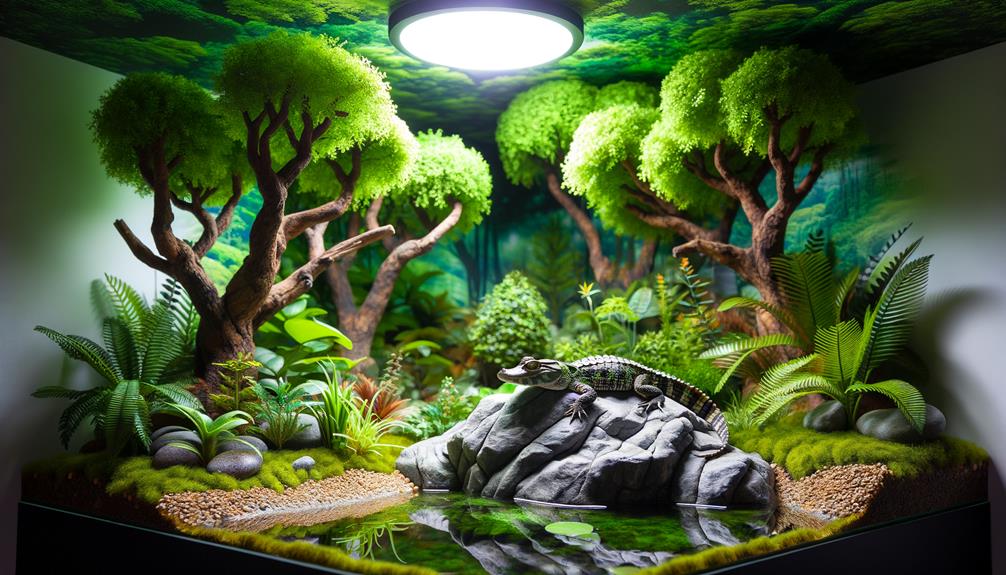
Captive Care for Cuvier's Dwarf Caimans: A Comprehensive Guide
Providing optimal care for Cuvier's dwarf caimans in captivity requires meticulous attention to their specific environmental and dietary needs. As the smallest crocodilian species, they still require a sizable enclosure – a minimum of 16×8 feet. It's crucial to ensure a blend of aquatic and terrestrial spaces, mimicking their native habitats in northern and central South America.
The water area should be at least 8×10 feet, with a depth of over 3 feet, featuring both deep and shallow zones. This setup allows the caimans to swim and rest comfortably. For the land area, which should be at least 6×8 feet, substrates like Bio Dude Terra Firma or large pieces of flagstone work well. Single housing is generally recommended, but pairs can be kept together if sufficient space is provided, and individuals are similar in size.
Their diet primarily consists of Mazuri Crocodilian Diet, a specialized food designed to meet their nutritional needs. Here's a quick reference table for their enclosure requirements:
| Aspect | Minimum Size | Details |
|---|---|---|
| Enclosure | 16L x 8W feet | Combination of water and land areas |
| Water Area | 8×10 feet, 3+ feet deep | Deep and shallow areas for swimming and resting |
| Land Area | 6×8 feet | Terra Firma substrate or large flagstone pieces |
While they're not recommended for beginners, with proper care, Cuvier's dwarf caimans can thrive in captivity, offering a fascinating glimpse into one of the smallest crocodilian species in the pet trade.
Frequently Asked Questions
What Is the Smallest Crocodilian?
The smallest crocodilian is the Cuvier's dwarf caiman, a tiny but resilient creature that rarely grows beyond 1.6 meters in length. Despite its small size, its armored body allows it to thrive in the wild.
Are Cuvier's Dwarf Caimans Good Pets?
In my view, Cuvier's dwarf caimans don't make great pets. They demand specialized care, spacious enclosures, and specific nocturnal conditions. Their unique needs and potential danger make them better suited to experienced reptile enthusiasts who have the proper facilities and necessary permits.
What Is the Smallest Caiman You Can Own?
The smallest caiman you can own is the Cuvier's dwarf caiman, which typically reaches around 5 feet in length. Despite its relatively small size, this species requires a substantial enclosure and specific care, making it a challenging pet to keep.
How Big Do Dwarf Caiman Alligators Get?
Imagine the agility of a compact jungle predator. Typically, dwarf caiman alligators reach around 1.6 meters in length for males and 1.2 meters for females. In rare cases, some can grow up to 2 meters, but that's an exception.


